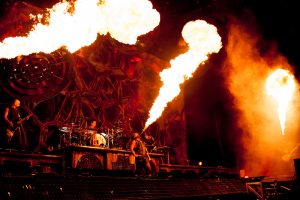The many dangers of working a rock concert
 As Green Day’s “Revolution Radio” tour finished its European leg recently, it is clear that the roadies responsible for running things behind the scenes are true health and safety heroes. Because the range of gimmicks and show devices used by Green Day go way beyond the basic working-at-heights concerns.
As Green Day’s “Revolution Radio” tour finished its European leg recently, it is clear that the roadies responsible for running things behind the scenes are true health and safety heroes. Because the range of gimmicks and show devices used by Green Day go way beyond the basic working-at-heights concerns.
Here are just a few of the hazards roadies must contend with:
Fire
Popular with other rock bands (and Nickelback), fire plays an integral part in several songs. At several points fireballs erupt into the air in time with Trey Cool’s drumming.
For the band and the stagehands, these flames present a significant risk. The machines responsible for launching fireballs must be carefully placed and tested before each show to ensure that they are functioning correctly. Everyone on stage must also be fully trained and aware of where these burners are located, and in which direction they shoot flame.
Lessons for your business: Dangerous equipment has to be fitted correctly – and employees must be made aware of safe operating zones.
Explosives and pyrotechnics
If fireballs weren’t big enough, Green Day also punctuate certain parts of their set with loud explosions and showers of sparks. And just like any explosive, these pyrotechnic devices present a risk to people on stage.
Each of the units is carefully placed so that it is well away from the band – and the audience. High visibility tape is placed on the stage, demarking ‘dangerous’ areas that should not be entered.
Lessons for your business: When using explosives on site you must always follow the relevant guidelines to ensure the safety of your workers. You should also clearly define and protect boundaries so that members of the public cannot be injured by explosions or debris.
High pressure water
Lead singer Billy Joe Armstrong takes great delight in using a pressure washer to spray water at the crowd. And judging by how hot and sweaty the mosh pits are, most of the audience welcome the temporary relief of cold water.
With so much electrical equipment mounted on, and around the stage, spraying water could be incredibly dangerous. It is clear that Billy Joe has been told never to squirt water in the direction of the stage.
Lessons for your business: Ensure that your staff are trained to separate water and electrics at all times. You should also deploy waterproofed electrics on site where there is a risk of them getting wet.
Missiles
If spraying water into the crowd wasn’t enough, Billy Joe also likes to fire t-shirts into the stands using a compressed air gun. Each shirt is propelled some distance – and at speed too.
Safe use of the gun relies on the singer aiming high into the air, rather than directly at anyone, helping to reduce the speed of the projectile.
Lessons for your business: Firing any kind of gun on site is ridiculously dangerous – consider banning anything but nailguns.
Members of the Public
One other “gimmick” employed by Green Day is on-stage audience participation. Fans are invited on stage to help play guitar or sing a song, before being encouraged to leap unsupported into the crowd.
Very little is actually done to protect these fans. They may be helped on stage by a burly bouncer, but after that, they are on their own. As they jump back into the crowd, they are completely reliant on the rest of the audience catching them before they hit the hard concrete floor.
Lessons for your site: When hosting visitors on site, always ensure that they are issued with a hard hat and appropriate footwear. You should also make sure that they are accompanied at all times, and escorted safely off site at the end of their visit.
A well-managed nightmare
Green Day concerts may be a health and safety nightmare, but they are well managed so that these risks are mitigated (in the main). The key is to identify these risks in advance, and to create safeguards that reduce potential for harm – a principle that applies to rock concerts and construction sites alike.
For more help and advice on risk management strategies, please get in touch.
Don’t miss a thing.
I hope you found this article useful.
If you did, you’ll be pleased to know that we provide regular how-to’s and industry guidance for businesses in construction, for free, a few times a month on Veritas Consulting Blog. You can have them delivered straight to your inbox.
Get new articles direct to your inbox. Just add your email below. We will respect your privacy.

A chartered (fellow) safety and risk management practitioner with 20+ years of experience. David provides a healthy dose of how-to articles, advice and guidance to make compliance easier for construction professionals, Architects and the built environment. Get social with David on Twitter and Linkedin.



